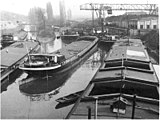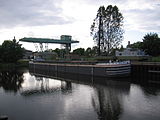Barge
The barge , also called tugboat or barge , developed from the early tow barges . Barges were used on inland waterways , which for centuries were the main routes of communication between seaport cities . Barges in today's inland shipping are no longer pulled, but are motor ships .
development
In Central Europe, very different types of piers, adapted to the respective waterway conditions, have been developed. These were sailed or grained by human or horse power and could only carry a little load. The main transport goods were products from the interior such as grain, coal, peat, wood, ores, salt and finished products as well as imported goods, so-called colonial goods . The open cargo holds, which could be covered by hatches, were separated by eight to 11 watertight walls (bulkheads). With the introduction of the steam tug in the 19th century, the barges could be built ever larger, up to 130 meters long on the Rhine and a payload of up to 2500 tons. There were open barges, those with hatch covers and tank barges . The crew had apartments on the barges, aft (rear), the so-called Roof , attended the skipper , also called Schiffer, with his family and at the front, mostly in the so-called Vorunter which sailors . Life on board was very simple, there was no electricity, coal stoves were used for heating. For a long time the anchor winches were still operated by hand. The work at the helm was very hard. Most of the boats had an open wheelhouse with a horizontal reel , which, depending on the size of the boat, was several meters in diameter. Depending on the water conditions, the entire crew had to stand at the helm. Barges are still used today on the Weser, Elbe and Danube, and you can still see them in the Netherlands.
Image examples
The barge Ilse-Lucie as a museum ship in the port of Pritzerbes
literature
- Holger Patzer: The river and port shipping of the DDG Hansa . HM Hauschild, Bremen 2009, ISBN 3-89757-140-4 .
- Paul Neubaur: Mathias Stinnes and his house. A century of development 1808-1908 . Mülheim an der Ruhr, 1908, online
Web links
See also
Individual evidence
- ↑ Dr. Paul Neubaur: Mathias Stinnes and his house. A century of development 1808-1908. Staatsbibliothek zu Berlin , 1908, p. 157 , accessed on April 18, 2016 : "Today some of the largest iron barges, this should be noted here in advance, load up to 50,000 quintals."
- ↑ private sea man's encyclopedia



